Feb 25, 2018 | cash, coins, commentary, currency
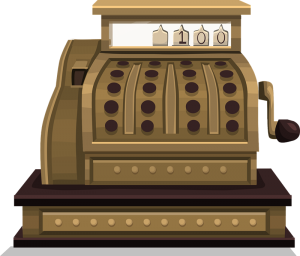 Here we go again. Another story about how one country is starting to go cashless and the pundits crawl out of the woodwork saying that the United States should do the same.
Here we go again. Another story about how one country is starting to go cashless and the pundits crawl out of the woodwork saying that the United States should do the same.
There are a lot of reasons why this will not happen in the United States. One of the biggest reason is the overall economic impact that can affect the actual strength of the U.S. dollar as the world’s reserve currency.
The strength of the U.S. dollar is based on the (relative) security of our government and that the Gross Domestic Product (GDP), the measure of all goods and services produced within a country. According to The World Bank 2016 data (the latest available), the United States has the largest economy with a GDP of over $18.6 trillion. Sweden, the world’s 22nd largest economy, has a GDP of over $514 billion. Their economy is 2.76-percent the size of the United States’s economy.
It is the difference between dumping a bucket of water versus draining an Olympic-sized pool.
But wait, you exclaim, the United States already has an economy that is already electronic and should be able to follow suit. According to the Federal Reserve Bank of San Francisco, based on 2016 data, 31-percent of all transactions are made in cash. Most of the cash usage, 60-percent, are for transactions of $10 or less with lower income people preferring cash over middle and higher income consumers.
“Since 2009, the compound annual growth rate (CAGR) for the number of notes in circulation has been 5.6 percent, with the value of currency in circulation growing at a 7.4 percent annual growth rate,” reports the San Francisco Fed.
When we are not using cash, we are using cash equivalences such as debit cards and pre-paid debit and credit cards. Credit-related purchases account for approximately 20-percent of all transaction.
Cash is not going away anytime in the near future which means that the U.S. Mint and Bureau of Engraving and Printing will continue to produce collectible numismatics for quite some time.
And now the news…

February 18, 2018
At a public toilet in a shopping centre in Gothenburg, a struggle is taking place between old and new Sweden. Last year, the the shopping centre installed cash-free toilets, forcing customers to pay with their mobile phones – a process new to most.  → Read more at theguardian.com
→ Read more at theguardian.com

February 18, 2018
South African Reserve Bank subsidiary, the South African Mint, has announced new collectables product ranges that will appear in the global coin market this year, including the ‘Celebrating South Africa’ series, which will commemorate the life of former President, distinguished Statesman and global icon Nelson Mandela.  → Read more at m.engineeringnews.co.za
→ Read more at m.engineeringnews.co.za

February 19, 2018
The coin, dubbed the Jewelled Phoenix, was crafted from 99.9 per cent pure gold and inset with 1.22 carats of rare, natural fancy pink diamonds from Rio Tinto’s Argyle diamond mine in Western Australia.  → Read more at jewellermagazine.com
→ Read more at jewellermagazine.com

February 21, 2018
FOR 60 years, generations of children have grown up with the lovable, marmalade-eating bear, created by the late Michael Bond. But now, it has been announced the Queen has ordered a batch of specia…  → Read more at thesun.co.uk
→ Read more at thesun.co.uk

February 23, 2018
CHAMBERSBURG, Pa. — The Franklin County (Pa.) Veterans and 9/11 Memorial Park now has a commemorative coin for guest speakers, dignitaries and donors.  → Read more at heraldmailmedia.com
→ Read more at heraldmailmedia.com

February 23, 2018
Japan’s government has unveiled designs for 5 commemorative coins for the 2020 Tokyo Olympics and Paralympics.  → Read more at www3.nhk.or.jp
→ Read more at www3.nhk.or.jp

February 23, 2018
CHANDIGARH: When the collection of original Sikh coins is available at half the price in the open market, the Punjab Government has paid lakhs of rupees to a private firm just for minting duplicate coins.  → Read more at tribuneindia.com
→ Read more at tribuneindia.com

February 23, 2018
JIM THORPE — Jim Thorpe Neighborhood Bank on Broadway was very busy with customers looking to get the latest Native American $1 coin. Take a closer look and you’ll see why. The coin has the face of the borough’s namesake etched into it — Jim Thorpe. "We actually heard about it at another store that they were getting coins issued for Jim Thorpe. It was very enjoyable to find out so we decided to walk down and come over here to the bank," said David Knarr, Hellertown.  → Read more at wnep.com
→ Read more at wnep.com

February 23, 2018
Kitco News' Weekly Gold Outlook recaps how the week's events affected the gold market, and where expert analysts think the metal is headed next. Every Friday, get an in-depth look into the metals space and see how experts see the fundamentals set up gold in the week ahead.  → Read more at kitco.com
→ Read more at kitco.com

February 24, 2018
THERE’s a new 50p coin causing a stir with collectors.  → Read more at dailystar.co.uk
→ Read more at dailystar.co.uk
Feb 22, 2018 | commentary, counterfeit, currency, education, scams, security
It is difficult to turn on the television, read the news, or visit social media without the tragedies of the day smacking us in the face. Although crime statistics are the lowest it has been in generations, there are some crimes that have seen a rise. Those are the crimes that are given the headlines and the most airtime on the news.
Unfortunately, the news extends beyond the mainstream but extends to Main Street.
Numismatics has not been a stranger to the criminal element. If it is not embezzlers using coins to defraud people and governments, there are the counterfeits primarily coming from China. Now there are two new scams that the industry has to watch.
Counterfeiting currency is definitely not a new issue. Counterfeiting the currency that is supposed to be the most secure is something that is now hitting the mainstream, especially in countries that have adopted the use of polymer notes, is important news.
Police in Saskatoon, Saskatchewan has reported the confiscation of 72 bogus Canadian banknotes. Counterfeiters are using a combination of printed plastic sheets and physical cut-and-paste of lower denomination notes to mimic higher denomination notes.
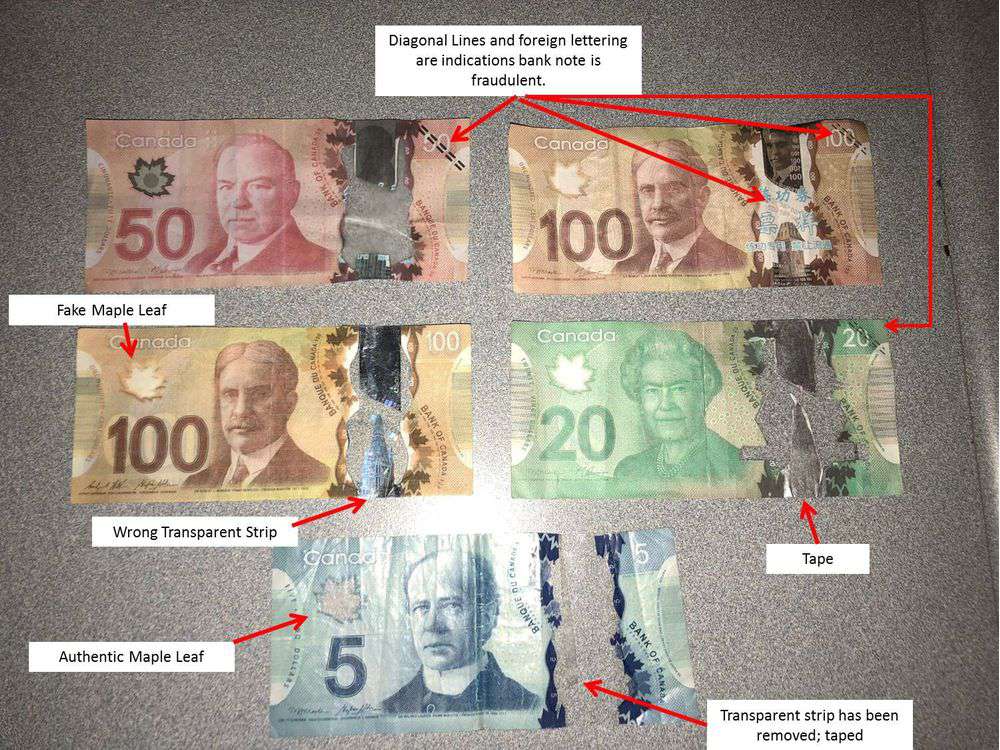
Image released by the Saskatoon Police showing the counterfeit currency (Image courtesy of the Saskatoon Police via the Saskatoon StarPhoenix)
Within the same news feed, the Bank of England issued warnings and additional guidance after counterfeit notes were used for purchases at pubs in Lincolnshire. Many stories from the U.K. suggest that the people do not seem to like the new polymer notes, but this does not seem to help.

Bank of England wants people to watch for the color shifting ink in the quill (Bank of England image)
The Reserve Bank of Australia (RBA), Australia’s central bank and the primary developer of the polymer substrate used around the world, has found that their currency is under attack by industrious forgers. One particular forger found a plastic substrate similar to the polymer developed by the RBA. The forger bought one high-quality commercial printer from the used market and rented two others to print Australian $50 notes.
According to the reports, the $50 note was picked because it provides is common enough to be used in daily transactions (AU$50 is equivalent to US$39.06 as this is being written) and high enough of a denomination to be cost-effective for the forger. Remember, forgery may be a crime but it is a business.

A counterfeit Australian $50 note has the wrong security stripes and the star field on the right is supposed to be clear (Image courtesy of The Sydney Morning Herald)
Although these issues have not directly affected the collectible currency market, it has had an effect on the dealers when their customers pay in cash. Even with the rise of electronic transactions, many European dealers continue to do over-the-counter sales using cash. In some countries, like Germany, cash is still king even when purchasing rare coins.
While discussing these issues with a dealer based in Germany, it was reported that he will not accept large sums of cash from customers he has not done business with in the past. This dealer does not accept credit card payments over 200€ or for any bullion-based transactions. His regular customers can directly wire the funds to a special account the dealer set up. Others must use certified bank checks.
This is not to suggest wire transfers are safe. In a blog post on Kovels.com, they have been contacted by antique dealers that reported money stolen by wire transfers. According to the blog post:
The fraudsters hack your emails and insert their own email, cloned to look like an email from a trusted person, into your email stream. They then request a wire transfer — providing all needed wire instructions — for something that looks legitimate. Once a bank wire is sent, it is extremely difficult, if not impossible, to get the money back. If you need to send a wire, be sure to use “old” technology and confirm on the telephone with someone that you know!
Even though I am no longer in the information security business, it is still my obligation to remind you that EMAIL IS NOT A SECURE FORM OF COMMUNICATION! Email is the electronic equivalent of a postcard. Any message you send, unless it is encrypted, can be read, scanned, snooped, and even altered by anyone, anywhere, at any time.
“Oh, it cannot happen to me!”
I used to hear that line when I taught a senior-level college class on information security. Using a laptop connected to an overhead projector, I was able to show the class how easy it was not only to create spam but to make it look like an email was sent by someone else. I was also able to demonstrate how to read the email traffic on the local network with a few keystrokes. Are you using wireless connections? You just made stealing your information easier for the hacker.
Counterfeiting and wire fraud are not just problems for dealers. When dealers are defrauded by these criminals, they have to recover the money in some way. Insurance does not cover all losses or the extra security that will be required to protect their transactions. Prices will have to go up to cover the losses and the future costs of doing business.
The cost of doing business in this environment is not a trivial subject. While dealers of all types of collectibles want you business, fraudsters are making it difficult for dealers trust the off-the-street buyer. This makes counterfeiting and fraud a problem for everyone.
Feb 18, 2018 | advice, coins, commentary, news
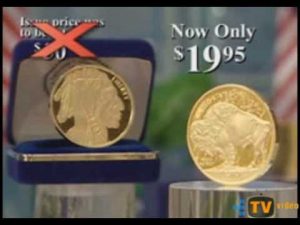
“Clad in 31 milligrams of pure gold,” or $1.34 in gold at the current price of $1,349.10 per troy ounce. (YouTube screen grab)
The elderly woman, like many other elderly who may not have the experience to deal with the sales pitch or understand the nuances of the particular investment, was smooth-talked by one of their salesmen who played on her emotions.
According to the story, the woman has infrequent contact with her children and used to look forward to the sales call from the NCM representative. Like similar scams, the representative likely fed on these emotions to convince her to buy NCM’s overpriced products.
The National Collector’s Mint settled on a fine of $750,000 from the Federal Trade Commission for advertising they were selling “official” 9/11 commemorative coins. The FTC claimed the ads were deception because no such coin was authorized by Congress, the only constitutionally legal entity to grant legal tender status to any coin from the United States. NCM settled without admitting guilt.
With all due respect to the National Collector’s Mint, they have advertised garbage collectibles before. Whether it is the not-so-official 9/11 commemorative coin or the tribute proof plated with gold with less than one-dollar in value, the television commercials that I have seen even on allegedly reputable cable channels is enough to make one gag on their coffee.
If you have elderly relatives living alone, give them a call. First, you will be doing a good thing especially if they are your parents. Even if there have been problems in the past, get over it. Life is way too short to hold a grudge. While talking with them, make sure they are not being taken advantage of by the likes of these scam artists. By talking with them they will not feel lonely and have to seek comfort in the voice of a smooth talker sitting in some cube farm in some sterile office.
Please remind them that if the deal sounds too good to be true, it is not a good deal! This includes the overpriced coins that are sold on the television shopping channels!
And now the news…

February 13, 2018
Our colleague Martin Shaw thinks he may have actually found a fake  → Read more at cornwalllive.com
→ Read more at cornwalllive.com

February 13, 2018
Thursday is the last day that one-cent, ten-cent and 25-cent coins can be used as legal monetary tender in Jamaica.However, the Bank of Jamaica (BOJ) will continue to redeem them indefinitely, during its regular business hours of 9 a.m. to 2 p.m….  → Read more at jamaica-gleaner.com
→ Read more at jamaica-gleaner.com

February 13, 2018
In many quarantines, these coins were the only form of money that patients affected by the disease could access.  → Read more at atlasobscura.com
→ Read more at atlasobscura.com

February 14, 2018
South Africans can expect a new coin and banknote issue with former President Nelson Mandela’s face on it later this year.  → Read more at timeslive.co.za
→ Read more at timeslive.co.za

February 14, 2018
An elderly Houston woman says an on-line coin seller based in New York took advantage of her loneliness to sell her $1.3 million in gold and silver coins at inflated prices. Patricia Thomas, 72, sued the National Collector's Mint in federal court in Houston, alleging that one of its sales representatives, under the guise of "checking in" with Thomas, smooth-talked her into to buying the coins, which cost more than twice what they were worth, according to court documents.  → Read more at chron.com
→ Read more at chron.com

February 15, 2018
To ensure you the best experience, we use cookies on our website for technical, analytical and marketing purposes. By continuing to browse our site, you are agreeing to our use of cookies.  → Read more at antiquestradegazette.com
→ Read more at antiquestradegazette.com

February 15, 2018
MINNEAPOLIS (KMSP) – Timberwolves players, coaches and fans paid tribute to the late Coach Flip Saunders at the Target Center. Saunders was honored as part of “Flip Saunders Night” at Thursday night’s game against the Los Angeles Lakers.  → Read more at fox9.com
→ Read more at fox9.com

February 16, 2018
Blackpool Tower is set to feature on a new silver £5 coin, an announcement by the Queen has revealed. The commemorative cash, which will be released ahead of the iconic structure’s 125th birthday next year, will be part of a series to celebrate British landmarks.  → Read more at blackpoolgazette.co.uk
→ Read more at blackpoolgazette.co.uk
Feb 16, 2018 | ANA, commentary
Did you know that January is National Hobby Month?
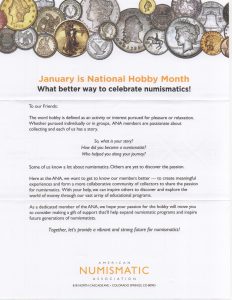
Letter from the ANA received in February.
Yes, but I did not know that January is National Hobby Month until I received a letter in the mail from the American Numismatic Association informing me of this fact.
The ANA, like other non-profit organizations, periodically send out what I like to call “beg letters” to members and those who have previously donated in order to solicit donations. There is nothing wrong with these letters. In fact, when I can I do respond to the organizations I regularly contribute to including the ANA.
What is unusual about this letter is that across the top, it tells me that January is National Hobby Month after being sent and received in February.
Since this came on a Friday and it was not opened until after hours, I have not attempted to contact the ANA to ask about this letter. However, if the ANA wants to tell me that January is National Hobby Month, maybe they should do it in January.
Feb 12, 2018 | commentary, medals, silver, US Mint
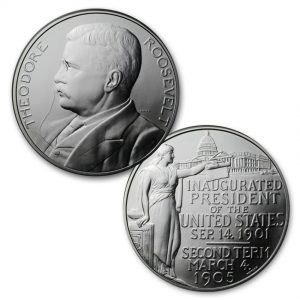
Silver Medal from the 2013 Theodore Roosevelt Coins and Chronicles Set
The U.S. Mint thinks that the silver medals would be a popular seller since silver coinage sells well. Using existing designs, the U.S. Mint hopes to be able to save time and money by removing the process of creating new images and not having to undergo the onerous review process of the CCAC and the U.S. Commission of Fine Arts.
I think the U.S. Mint is missing a point. Collecting commemorative silver and American Silver Eagle coins have the cache of being legal tender coins.
Although there are some very dedicated collectors of medals and other exonumia, the vast majority numismatics collectors are collecting legal tender coins.
If you look at the offering of some of the most prolific world mints like the Royal Canadian Mint, New Zealand Mint, and the Perth Mint, they offer a wide variety of offerings as legal tender coins. Countries like Niue and Somalia contract with other world mints to produce non-circulating legal tender (NCLT) coins to sell to the public.
Many of these programs are a success because they are legal tender coins. It is a mindset that the coins are worth more because they are legal tender. Even coins advertised as being legal tender from Native American Nations (tribes) gain attention.
People are drawn to the concept of collecting and/or investing in real money.
Medals are not money.
Although it sounds like a harsh assessment of the concept, the only downside that can be foreseen is if the U.S. Mint faces a planchet shortage like it did in 2009. Otherwise, I am not sure it will sell like I think the U.S. Mint is portraying.
For the first poll of 2018:

Loading ...
Jan 22, 2018 | commentary, news, policy, US Mint

Sen. Chuck Grassley (R-IA)
According to the notice filed in the Congressional Record:
Mr. President, I intend to object to any unanimous
consent request at the present time relating to the nomination of David J. Ryder, of New Jersey, to be Director of the Mint,
PN1355 .
I will object because the Department of the Treasury has failed to respond to a letter I sent on September 29, 2017, to a bureau within the Department seeking documents relevant to an ongoing investigation by the Senate Committee on the Judiciary. Despite several phone calls between committee staff and Treasury personnel to prioritize particular requests within that letter, the Treasury Department has to date failed to provide any documents.
My objection is not intended to question the credentials of Mr. Ryder in any way. However, the Department must recognize that it has an ongoing obligation to respond to congressional inquiries in a timely and reasonable manner.
Charles E. Grassley is a seven-term Republican Senator from Iowa. Grassley has a history of abusing† the Department of the Treasury to make it look like he’s doing something to keep his seat in the Senate. It is common for Grassley to have something to complain about without substance regardless of the ramifications of his actions.
In the meantime, the U.S. Mint remains without a permanent director while Grassley has his hissy fit.
PN1355: David J. Ryder — Department of the Treasury
Date Received from President: January 8, 2018
Summary: David J. Ryder, of New Jersey, to be Director of the Mint for a term of five years, vice Edmund C. Moy, resigned.
Received in the Senate and referred to the Committee on Banking, Housing, and Urban Affairs. — Jan 8, 2018
Committee on Banking, Housing, and Urban Affairs. Ordered to be reported favorably. — Jan 17, 2018
Reported by Senator Crapo, Committee on Banking, Housing, and Urban Affairs, without printed report. — Jan 17, 2018
Placed on Senate Executive Calendar. Calendar No. 596. Subject to nominee’s commitment to respond to requests to appear and testify before any duly constituted committee of the Senate. — Jan 17, 2018
† If you look at Grassley’s record, he has a record of making outlandish claims and using his office against Treasury bureaus regardless of the party in the White House. In 2005, I was involved with a Treasury bureau forced to a hearing in the Senate. Even though the evidence showed the contractor was clearly derelict in the performance of their contract, Grassley did everything except put on knee pads in deference to the contractor. Outside of the hearing room, I had a confrontation with one of his staffers and offered to supply the knee pads so that Grassley could complete the job. Since that hearing, I have held Grassley in contempt for being a bully and not a representative of the interests of his constituents in Iowa.
Jan 21, 2018 | Australia, Canada, coins, commentary, news
One of the more interesting news items is that the Royal Canadian Mint is suing the Royal Australian Mint.
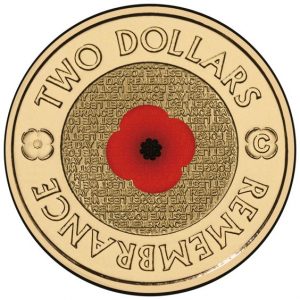
The Royal Canadian Mint alleges the Royal Australian Mint infringed on its patents when creating the 2012 Remembrance Day $2 coin.
Reports state that the two sides have tried to discuss the matter over the last two years. When no agreement had been reached, the Royal Canadian Mint decided to sue for relief. The Royal Canadian Mint is demanding that Australia hand over all 500,000 of the Remembrance Day coins struck or “destroyed under supervision.”
Since the Royal Canadian Mint is a crown corporation, it is an independent entity of the Canadian government. It has its own corporate and governance structure mandated by law. For those in the United States, it is similar to the relationship that Fannie Mae and Freddy Mac have with the United States government. On the other hand, the Royal Australian Mint is an agency in the Australian government in the same manner that the U.S. Mint is an agency in the United States government. Therefore, the Royal Canadian Mint is suing the Commonwealth of Australia.
“The applicant has suffered, and will continue to suffer, loss and damage by reason of the acts of the respondent pleaded above,” the statement of claim filed by the Royal Canadian Mint reads. Really? The Royal Canadian Mint has suffered because the Royal Australian Mint created a coin with a colored poppy for sale and distribution in Australia?
If the Royal Australian Mint infringed on the Royal Canadian Mint patent then there may be a case for relief owed for using the technology. But if the Royal Canadian Mint is trying to make a case based on the suffering of damages from sales of circulating versus commemorative coins, I think that the Royal Canadian Mint may be royally going in the wrong direction.
And now the news…

January 15, 2018
“At a time when our national debt is over $20 trillion, it is more and more difficult to find money for important things like cancer research,” – Congresswoman Carolyn Maloney.  → Read more at womensenews.org
→ Read more at womensenews.org

January 17, 2018
Online dealer sold 30kg of gold Tuesday, worth more than $1m Bitcoin tumbles below $10,000 for first time since December Amid the wild Bitcoin ride that’s wiped more than 40 percent off the cryptocurrency’s price in a month, a pattern may be emerging: sellers are switching out of digital gold and into the real thing.  → Read more at bloomberg.com
→ Read more at bloomberg.com

January 17, 2018
Gold’s liquidity and stability have made it an attractive option for investors in recent years. There are many ways to invest in gold. Investopedia lists gold futures, investing in old companies, gold EFTs, gold mutual funds, gold bullion, gold jewelry, and, of course, gold coins.  → Read more at newsmax.com
→ Read more at newsmax.com

January 17, 2018
After more than a year, visitors to the Nevada State Museum can watch the museum's historic Coin Press No. 1 carry on a mission it started nearly 150 year ago in the same building. The venerable press — which churned out millions of dollars in silver and gold coins during stints at U.S.  → Read more at nevadaappeal.com
→ Read more at nevadaappeal.com

January 18, 2018
OTTAWA — The Royal Canadian Mint is suing its Australian counterpart over the way it prints red poppies on its commemorative Remembrance Day coins. Documents filed in Australia’s Federal Court in December allege The Royal Australian Mint used without permission a printing method patented by the Canadian mint — which is now demanding that Australia’s 500,000 commemorative $2 coins, in circulation since 2012, either be turned over to them or “destroy(ed) under supervision.”  → Read more at nationalpost.com
→ Read more at nationalpost.com
Image courtesy of the Royal Australian Mint and had to be downloaded from Internet archives since it was deleted from their website.
Jan 14, 2018 | coins, commentary, news
One of my favorite quotes is from philosopher, essayist, poet, and novelist George Santayana who wrote, “Those who cannot remember the past are condemned to repeat it.” I was reminded about this quote while reading the news and stumbling over a story “Stamp Out the Sexist Legacy of the Dollar Coin” by Addison Nugent.
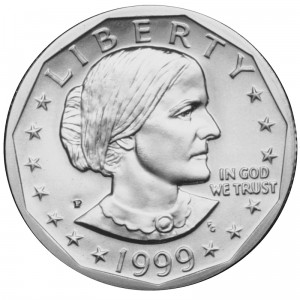
The Susan B. Anthony dollar coin was introduced in 1979 with much fanfare for being the first coin to honor a woman. The coin was a failure because it was confused with a quarter
Nugent complains that the design of the coins and the fact that they use the visage of a female as the reason these dollar coins have not been successful. What Nugent failed to do is learn from history and the facts.
The failure of the Susan B. Anthony dollar was not because the coin depicted a woman or was called the “Agony Dollars” (I had never heard this term before reading the article). The coin failed because of the decision to make it too close to the size to the Washington quarter, had reeded edges like the Washington quarter, and on a simple glance was consistently confused with the Washington quarter. The confusion made the coin very unpopular in the United States but continues to find usage in other countries whose currency is based on the U.S. dollar.
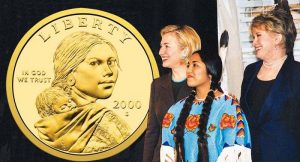
The unveiling of the Sacagawea Dollar design at the White House with (L-R) First Lady Hillary Clinton, Sacagawea Model Randy’L He-dow Teton, and Designer Glenna Goodacre.
Nugent then wrongly notes that “Sacagawea coins were pulled from circulation from 2002-2008 and from 2012 onward.” I do not know where she gets her facts from, but the reality is that the U.S. Mint, Department of the Treasury, and Federal Reserve does not recall paper currency or coins from circulation. What happens is that when there is no demand for a coin the Federal Reserve stops ordering them from the U.S. Mint.
The reason that the dollar coin does not circulate is not that it depicts a woman. The dollar coin does not circulate because the public has chosen paper over a coin. Even though studies have shown that the public can adopt and that there would be a savings to the government if the paper dollar was no longer printed (see the Government Accountability report GAO-13-164T), Congress does not have the intestinal fortitude to eliminate the paper dollar.
To add insult to the facts, Nugent does not take into consideration that the Sacagawea dollar was changed starting in 2009 to the Native American $1 Coin Program. While Sacagawea continues to appear on the obverse, the reverse honors Native American history. The last I looked the Native American population has undergone a significant negative history in the United States.
Another fact that Nugent does not acknowledge is that even though the U.S. Mint does not produce these coins for circulation they are produced for the collector market. In addition to being included in mint and proof sets, there have been special sets created with Native American coin honoring their accomplishments. Aside from being able to purchase these coins at face value in any U.S. Mint and Bureau of Engraving and Printing facility open to the public, you can also go to any bank and request they obtain a roll for you from the Federal Reserve.

Series 1886 $1 Silver Certificate featuring Martha Washington (Fr #217)
Although I agree with Nugent that United States coins and currency should be more diverse and I am in favor of removing Andrew Jackson, who was responsible for the Trail of Tears, from the $20 note, it is difficult to side with any argument whose purpose is based on factual errors.
And now the news…

January 7, 2018
Popular online magazine Atlas Obscura recently became the latest to probe the question of how an 11th century Viking penny came to rest on the coast of Maine. In the decades since the 1957 discovery by amateur archaeologists, it’s been denounced as a hoax, validated by scholars, denounced as a hoax again and — as recently as this past November — validated by scholars again.  → Read more at thinkmaine.bangordailynews.com
→ Read more at thinkmaine.bangordailynews.com

January 8, 2018
A similar coin sold for more than £4,000 in a 2011 auction, but Jason has gone down the correct route of declaring it as treasure  → Read more at plymouthherald.co.uk
→ Read more at plymouthherald.co.uk

January 8, 2018
The U.S. dollar coin has been the only American currency to regularly feature women. With these leading ladies now ousted, it's time to toss the coin.  → Read more at ozy.com
→ Read more at ozy.com

January 8, 2018
The United Kingdom’s round pound coin will no longer be accepted as a form of payment for services and retail purchases in shops after February 28.  → Read more at iomtoday.co.im
→ Read more at iomtoday.co.im

January 8, 2018
When Eric Lawes set off for a field in Hoxne village, Suffolk on November 16, 1992, it wasn’t on a treasure hunt. The metal detector he’d received as a retirement gift was meant to find a hammer lost on the farmland.  → Read more at smithsonianmag.com
→ Read more at smithsonianmag.com

January 9, 2018
JAMES Grear started selling coins with his best mate Henry when they were just 18. The pair were fed up with working as labourers on a building site in Bristol earning up to £9 per hour and decided…  → Read more at thesun.co.uk
→ Read more at thesun.co.uk

January 10, 2018
State Police are working to find the owners of a large bicentennial medallion coin. It was recovered months ago, but no one has stepped up to claim it.  → Read more at mpnnow.com
→ Read more at mpnnow.com

January 10, 2018
Colonial Williamsburg has acquired a rare and iconic Danish abolitionist medal that commemorates a royal edict to end the slave trade. The bronze medal was struck in 1792 and is one of only a handful known to exist, according to a Colonial Williamsburg Foundation press release.  → Read more at wydaily.com
→ Read more at wydaily.com

January 10, 2018
By Baek Byung-yeul Organizers for the 2018 PyeongChang Olympics unveiled a new limited coin set for the Winter Games, Wednesday. At the building of Poongsan Corporation in Seoul, the maker of the PyeongChang Olympics commemorative bill, the organizing committee made public the new package.  → Read more at m.koreatimes.co.kr
→ Read more at m.koreatimes.co.kr

January 12, 2018
Grip the handle and turn the crank. Watch the roller turn. Wait for that clink, reach into the little door.  → Read more at stltoday.com
→ Read more at stltoday.com
Jan 12, 2018 | coins, commemorative, commentary, US Mint
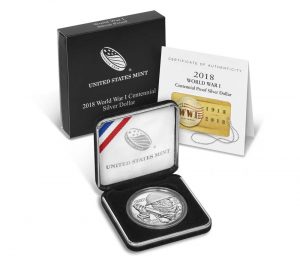
World War I Centennial 2018 Silver Dollar
Of course, the U.S. Mint will sell an uncirculated and proof silver dollar that will come in their usual display cases with a Certificate of Authenticity. These are the coins that are required under the authorizing law (World War I American Veterans Centennial Commemorative Coin Act, Public Law 113-212) that were designed by LeRoy Transfield.
The U.S. Mint will also be selling five silver medals that will be issued in conjunction with the 2018 World War I Centennial Silver Dollar. Each medal, composed of 90 percent silver, pays homage to branches of the U.S. Armed Forces that were active in World War I: Army, Marine Corps, Air Service, Navy, and Coast Guard. Medal designs were announced last October. However, the U.S. Mint will only be selling the medals as part of a set with the silver dollar.
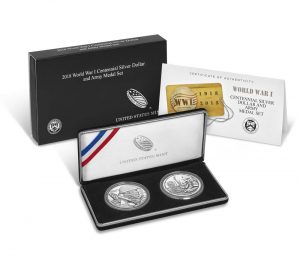
World War I Centennial 2018 Silver Dollar and Army Medal Set
Since there are no more surviving veterans of World War I, one can only assume that the commemorative coin and medal sets are being marketed to those that want to remember the service of those veterans. Creating these sets in this context makes sense. It does not make sense for the collector or for someone whose family did not serve in World War I or wants to just collect the medals.
This short-sightedness by the U.S. Mint may hinder potential sales of the commemorative coin whose proceeds are to benefit the United States Foundation for the Commemoration of the World Wars, an organization responsible for making sure we do not forget those who served.
With the decline in silver prices and the market interest in investing in silver at its lowest since before the Great Recession, a short-sighted decision like this will limit the sale of silver medals. This will lower the income and seigniorage the U.S. Mint will collect after seeing a decline in the sales of bullion-related products.
If the U.S. Mint cannot get this right, then maybe they should have a more broad community discussion so they can better understand the potential collector market because on this, they bombed!
Images courtesy of the U.S. Mint.
Dec 4, 2017 | commentary
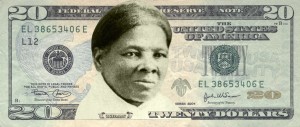 Although this blog is about numismatics, there are times when the news of the day reminds us that we not perfect beings and there are lessons learned that should apply to the hobby.
Although this blog is about numismatics, there are times when the news of the day reminds us that we not perfect beings and there are lessons learned that should apply to the hobby.
For the last few months, there have been reports about how sexual harassment has been pervasive in industries where men hold a great deal of power. Most people are not surprised when politicians are caught up in these types of activities because we do not hold these people in high regard.
Stories out of the entertainment industry should not be surprising either. It is a system where the “talent,” the faces you see on the television or movie screen, are treated better (or worse) than spoiled children. When I worked for NBC in the early 1990s, I saw first-hand how the talent could do no wrong while their behinds were kissed by the production staff. This created an air of omnipotence that also lead to people being treated badly, something I witnessed regularly.
While there are bad actors in every industry, there seems to be a pattern in male-dominated industries. This is why there is an emphasis on teaching science, technology, engineering, and math (STEM) to girls in order to break the stereotypes. In fact, go to the website of almost any small tech company and look at the list of employees. Not only are most of the employees male, most are white, and what they call diversity includes a male from India or Taiwan. The women listed are in support roles and have no technical responsibility. There are also very few people over 40 years old in most of those companies.
Numismatics is no better. Although the current executive director of the American Numismatic Association is a woman and there quite a few women helping to support the ANA in Colorado Springs, it is not often you see a woman serve on the ANA Board of Governors. The last one was Laura Sperber. While I have disagreed with Sperber, I respect the fact that not only she is a successful business person and had the wherewithal to run for the Board of Governors.
The last time a woman ran for ANA President was in 2009 when Patti Finner, whom I endorsed, lost to Cliff Mishler.
Go to any coin show and count the number of women and minorities behind the tables. A few small shows I have attended were only represented by older white men. At the recent Baltimore Expo although there were a few women, the only one I encountered is one I regularly see who carries foreign currency who is not a native of the United States.

Having the ablity for business to diversify reminds me of the lessons learned in
Built to Last, a book I was required to read in graduate school. The book is a study of companies that were able to adapt and diversify to allow their companies rise above their issues to be successful. They were compared with companies who did not or could not adapt to find their influence reduced or that led to their failure.
These attitudes are not sustainable for the hobby and society.
Look at the backlash that came when it was announced that the Department of the Treasury wanted to change the portrait on the $20 note to a woman. She would replace Andrew Jackson who ignored treaties and supported the Indian Removal Act that led to the Trail of Tears, an action that is a stain on the nation’s history. There was opposition to these policies during that time. But as Senator William L. Marcy (D-NY) said in defense of Jackson, “To the victor belong the spoils.” One of those spoils is that they get to write the history books and chose figures like Jackson to (dis)honor currency.
But how many people in the numismatic industry stood up for the decision? There were some defenders, but overall there was a deafening silence.
I have complained that the hobby is too white, male, and over the age of 50. I do not think this is sustainable in a changing world, says your blogger who is white, male and over the age of 50. And that can be evident by walking the bourse floor of any coin show.
The old boys club should stop being old and a club of boys. Embracing diversity will only help the hobby because it will bring in new people and new ideas.
Young Numismatist programs help but they should not be the only focus. There is a lack of programs to keep the YN interested and engaged after no longer being YNs. Both male and female YNs become disengaged as they reach young adulthood. I know it is a problem and I keep bringing this up as an issue, it is another time where the silence as to what can be done is defening!
Just because that is the way it has been does not mean it will be the same in the future.
The hobby needs diversity of all types. We need to not only find a way to attract more hobbyists under 50 years old, women, and non-caucasions.
I am open to suggestions!
As society grapples with the news about the dozens of men that have been accused of being general pigs and the far too many more that are not associated with the media and are not reported, this hobby has to look at itself and wonder why the bourse floor looks like an old boys club and is that sustainable.
Maybe it is time for the numismatic-related industries to be a leader and show how we can set the stereotypes aside and encourage diversity. Or as the business adage suggests: Diversify or Die!
 Here we go again. Another story about how one country is starting to go cashless and the pundits crawl out of the woodwork saying that the United States should do the same.
Here we go again. Another story about how one country is starting to go cashless and the pundits crawl out of the woodwork saying that the United States should do the same. → Read more at theguardian.com
→ Read more at theguardian.com → Read more at m.engineeringnews.co.za
→ Read more at m.engineeringnews.co.za → Read more at jewellermagazine.com
→ Read more at jewellermagazine.com → Read more at thesun.co.uk
→ Read more at thesun.co.uk → Read more at heraldmailmedia.com
→ Read more at heraldmailmedia.com → Read more at www3.nhk.or.jp
→ Read more at www3.nhk.or.jp → Read more at tribuneindia.com
→ Read more at tribuneindia.com → Read more at wnep.com
→ Read more at wnep.com → Read more at kitco.com
→ Read more at kitco.com → Read more at dailystar.co.uk
→ Read more at dailystar.co.uk














